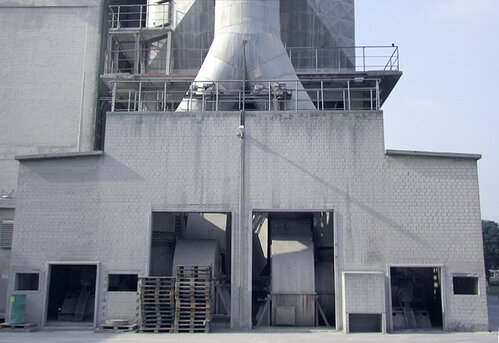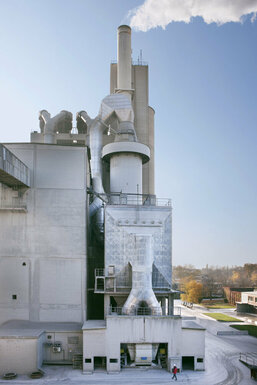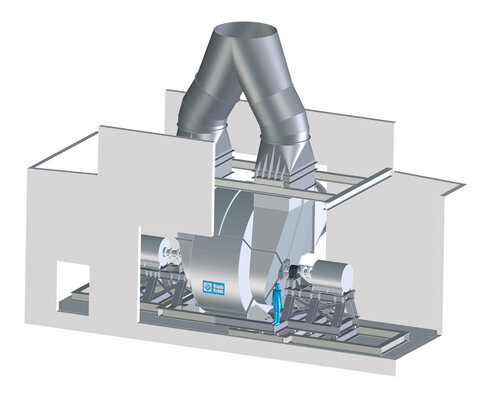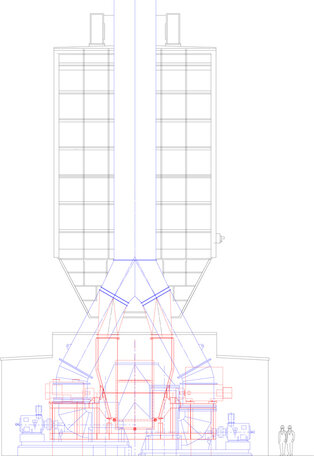ZKG International journal talking with Norbert Vering and Heinz Bröke
Video: Description of the erection sequence HeidelbergCement, Ennigerloh
Cement production using lime marl has been going on for over 100 years in the Ennigerloh HeidelbergCement AG works. Ongoing modernisation ensures a lasting, competitive building material production. Associated with this is the regular inspection of plant components. It was such a plant inspection which revealed that, as a result of wear on the impellers and considerable damage to the casings and casing feet of the existing electrostatic precipitator fans, built in 1973, type HK 200/240, repair work had become essential (Fig.1).

Various forms of remedial action were discussed and worked on in the run-up stage. The decision was then taken to replace the two substantially damaged fans with one high-efficiency centrifugal fan with “duplex” drive (Fig. 2 and 3).


Replacing the ESP fans in the kiln plant in Ennigerloh has shown the great potential for saving provided by modern fan technology. The potential predicted during the project stage can be seen in the modernized plant component, meaning that a payback period of about 4 ½ years soon puts the original investment into perspective. ZKG spoke to Mr Heinz Bröker (Head of Production in the Ennigerloh HeidelbergCement AG works) and Mr Norbert Vering (Sales, Ventilatorenfabrik Oelde) about the project.
ZKG: Mr Bröker, What was the decision-making matrix for the modernisation project?
Heinz Bröker: As a result of the pending substantial costs of repairing the existing fans compared to the costs for the purchase of a new fan and the energy saving made possible by modern fans, we focussed during the final project stage on the replacement of both fans, while taking certain aspects into consideration. The fan modification should mainly be rewarded by a saving in electricity as a result of the modern fan design. To achieve this it was necessary to select a fan layout which retained the two existing direct current drives with adjusted drive control. For the complex exhaust gas connections of the kiln plant with auxiliary plants a fan characteristic curve is required which, if possible, covers all operating points in an energy-efficient manner. Changes in the exhaust gas volumes must be taken into consideration.
ZKG: Mr Vering, What were the demands made on the technical concept?
Norbert Vering: The new installation is a special construction with duplex drive, i.e. there is a drive on both the locating and non-locating bearing sides. A motor pedestal was constructed in such a way that at a later date the fan can be modified to a single motor version. The Venti standard construction was altered so that the two existing baseframes could be re-used (Fig. 4). This means that neither new anchors nor foundation work were required. It was also possible to carry out the work in winter at outdoor temperatures down to -15 °C. The construction was optimally adapted to the building situation. Casing splits were dictated by the assembly situation, assembly progress and ease of maintenance.

ZKG: That sounds as if there were particular specifications during the project planning stage?
Norbert Vering: Yes, in the forefront the assembly sequence was planned down to the last detail. This meant that when HeidelbergCement had placed the order for the fan, they were able to outsource the assembly work. Final assembly inspection including alignment and commissioning was carried out by Venti customer service personnel on conclusion of a three week assembly.
ZKG: Mr Bröker, were there particular aspects to consider in this project in Ennigerloh?
Heinz Bröker: A peculiarity of the kiln plant operating connection in Ennigerloh is the capacity range of the ESP fans. The interconnected operation with the raw mill is controlled via the relevant ESP fan without an individual raw mill exhaust air fan. The necessary operating pressure on the preheater fan is regulated through the ESP fans for all operating connections, with or without raw mill, with or without granulated blast furnace slag drying and coal grinding plant as well as bypass filter operation. The electrical power consumption of the fans varies greatly, therefore, at the different exhaust air volumes. The power consumption of the two fan drives is 5.7 million kWh/a.
ZKG: Mr Vering, Which was the preferred plant layout?
Norbert Vering: As a result of the specified parameters the choice of fan design was limited to a double-inlet exhaust air fan (gas inlet on two sides through two inlet boxes and central gas outlet), with corresponding exhaust gas volume. Figure 5 shows the replacement situation. In the previous situation (blue), the gas inlet to the two old fans arranged at the side with the separate gas diffuser flow and gas merging can be seen. In the new plant (red), the steep gas inlet leads to the centrally arranged fan and the central gas diffuser flow. To the right and left the two direct current drives can be seen on a shaft.

ZKG: Mr Bröker, How did the schedule for the project look?
Heinz Bröker: We had a window of three weeks to complete all dismantling and assembly work. Delivery and assembly went according to schedule without any great changes. The plant was completed according to plan for the scheduled commissioning. Adjustment of the control of the DC drives to master-slave operation was carried out by Siemens. After cold commissioning, it was possible for the plant to be heated up and started without any direct supervision by the firms involved. Apart from necessary parameter adjustments in the drive control commissioning proceeded without any great hitch. The upgrading work was carried out during December 2010 under the extreme conditions of winter 2010/2011. Warm commissioning was accomplished in January 2011 after the kiln plant had been heated up. The kiln plant was run up to the usual exhaust gas volumes without any hold-ups.
ZKG: Have you been able to evaluate the performance of the new ESP fan, Mr Bröker?
Heinz Bröker: On conclusion of work consequent to the kiln inspection, the electrical power data of the plant were recorded and detailed flow volume measurements carried out at the beginning of February. These showed an average saving of about 200 kW per kiln operational hour as a result of upgrading the ESP fans.
ZKG: So considerable energy-savings have been made. What is the potential for further optimisation?
Heinz Bröker: At the currently attainable exhaust gas volumes, a saving of about 1010 t CO2/a can be achieved, in accordance with the annual distribution of the operational connections. The current situation, now that the modification has been made, shows a clearly improved plant energy budget.
Norbert Vering: In the first constructional stage the performance characteristics of the fan were selected so that with the two existing drives the previous exhaust gas volume of the two old fans was reached. The new fan makes possible a relevant energy-saving for all service conditions.
ZKG: What is your conclusion, Mr Vering?
Norbert Vering: The detailed planning and discussions up-front have proved their worth in that assembly went smoothly and to schedule. The plant has been operating without problem since the beginning of January 2011. A flow-optimized connection to existing inlet and outlet ducts was considerably improved and simplified by relevant model calculations. Within the framework of a flexible concept, the re-use of the existing drives 2 x 560 kW was possible, resulting in energy-saving operation while attaining the previous exhaust gas flow volume. The possibility has also been given of changing to a higher-power drive of 1 x 2500 kW with frequency-regulation at a later date. Everything considered, it was for us an informative but also very successful project which illustrates the saving potential of modern plant technology. The payback time of the investment is only about 4 ½ years.
ZKG: Mr Bröker, How would you summarize the project?
Heinz Bröker: A considerable share in the saving of energy was provided by selecting an appropriate fan for the individual case with a specific fan characteristic curve. There is a large energy-saving potential in all the plant operating connections. In a normal replacement the existing drives can be retained. With the improved efficiency there are, therefore, reserves in the exhaust gas volume and these can be taken into account during designing. Venti Oelde proved to be a competent partner with ample experience in the construction of large fans. Calculations made beforehand were confirmed when measurements were taken during acceptance. The calculated energy-savings will be easily reached – what more do we want?
ZKG: Thank you for granting us this interview.

关注万迪欧德公众号

万迪欧德抖音号
Copyright © 2022-2023 Venti Oelde (Jiangsu) Air Handling Equipment Co. Ltd All Right
备案号:ICP 2023002554 技术支持:镁诚科技